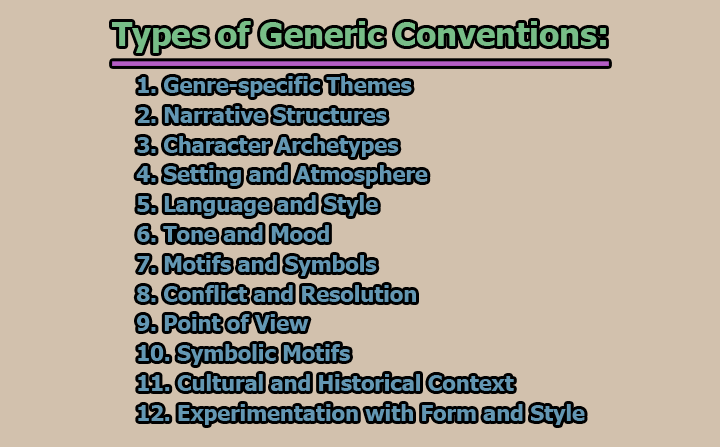Literature, a timeless and expansive realm, has always been a dynamic medium for human expression. Within this vast landscape, generic conventions play a pivotal role in shaping and defining the various genres that have emerged over centuries. These conventions, consisting of common themes, styles, and structures, provide a framework for writers to communicate their ideas effectively while allowing readers to navigate and interpret the text more readily. In this article, we will explore the evolution, importance and types of generic conventions in literature.
Generic Conventions:
Generic conventions refer to the set of common features, themes, styles, and structures that define and characterize a particular literary genre. These conventions act as a framework or set of guidelines that both writers and readers can expect within a specific genre, providing a shared language and expectations. Generic conventions include elements such as themes, narrative structures, character archetypes, settings, and language styles. They play a crucial role in facilitating communication between authors and readers, allowing for a more immersive and understandable experience within a given genre.
Evolution of Generic Conventions:
The evolution of generic conventions in literature is a dynamic process influenced by cultural shifts, historical developments, literary movements, and the constant interplay between writers and readers. Understanding how generic conventions evolve provides insights into the ever-changing nature of literature. Here are key factors contributing to the evolution of generic conventions:
1. Cultural and Historical Influences: Generic conventions often reflect the values, beliefs, and concerns of the societies in which they emerge. Changes in culture and historical events influence the themes, settings, and character dynamics within genres. For example, the Gothic genre evolved in response to societal anxieties and fascination with the mysterious and supernatural during the Romantic era.
2. Technological Advances: Advances in technology can give rise to new genres or reshape existing ones. The cyberpunk genre, for instance, emerged as a response to the rapid technological developments and cyberculture of the late 20th century. As technology continues to evolve, new genres and sub-genres may emerge, reflecting society’s relationship with innovation.
3. Literary Movements and Trends: Literary movements, such as Romanticism, Modernism, and Postmodernism, have had a profound impact on the evolution of generic conventions. Writers associated with these movements often challenged or subverted traditional genre expectations, leading to the creation of new forms and styles.
4. Interconnected Genres and Hybridization: Genres are not static entities; they interact and influence one another. The blending of genres, known as hybridization, has led to the creation of new and innovative forms. For example, the genre of speculative fiction encompasses elements of science fiction, fantasy, and horror, showcasing the interconnected nature of generic conventions.
5. Reader Participation and Feedback: Readers actively contribute to the evolution of generic conventions through their reception of works and feedback to authors. As readership diversifies, there is a demand for fresh perspectives and voices, leading to the exploration of new themes and the redefinition of existing conventions.
6. Globalization and Cultural Exchange: Increased globalization and cultural exchange have facilitated the introduction of diverse cultural elements into established genres. This cross-pollination enriches the literary landscape, broadening the scope of generic conventions and challenging traditional norms.
7. Social and Political Movements: Social and political movements often find expression in literature, influencing the themes and perspectives within genres. For instance, feminist movements have contributed to the evolution of gender roles and representations in various genres, promoting more diverse and inclusive storytelling.
8. Experimentation with Form and Style: Writers often experiment with narrative forms and styles, pushing the boundaries of conventional storytelling. The stream-of-consciousness technique in Modernist literature or the fragmented narrative structures in postmodern works exemplify how experimentation with form can redefine generic conventions.
9. Digital Media and Online Communities: The advent of digital media and online communities has transformed the way literature is consumed and discussed. Authors and readers interact in real-time, leading to a more immediate and participatory relationship. This digital age has given rise to new forms of storytelling and collaborative storytelling efforts that challenge traditional genre boundaries.
10. Economic and Publishing Influences: Economic factors and publishing trends also play a role in the evolution of generic conventions. Market demands and reader preferences can influence the creation and modification of genres to meet changing expectations.
Importance of Generic Conventions:
The importance of generic conventions in literature cannot be overstated, as they serve several crucial roles in shaping, defining, and enriching the reading experience. Here are key reasons why generic conventions hold significance:
1. Communication and Understanding: Generic conventions serve as a shared language between writers and readers. When an author adheres to the conventions of a particular genre, readers can anticipate certain elements in the text, making it easier to understand and engage with the work.
For instance, the detective novel genre often includes elements such as a crime, an investigator, and a resolution. Readers familiar with these conventions can quickly recognize and appreciate the structure of a detective novel, enhancing their overall reading experience.
2. Artistic Freedom within Constraints: While generic conventions provide a framework, they also allow for artistic expression within defined boundaries. Writers can experiment with themes, characters, and styles while still conforming to the expectations of a specific genre.
This balance between structure and flexibility enables literary innovation. For example, science fiction writers can explore diverse futuristic scenarios while still adhering to the core conventions of the genre.
3. Reader Expectations: Generic conventions create expectations for readers, and meeting or subverting these expectations can be a powerful tool for writers. By understanding and manipulating these expectations, authors can create suspense, surprise, or irony.
In a romance novel, for instance, readers may expect a happy ending. An author can choose to fulfill this expectation or defy it, providing a unique twist that adds depth to the narrative.
4. Genre Recognition and Categorization: Generic conventions aid in the categorization of literary works into specific genres. This helps readers identify the type of story they are engaging with, enabling them to choose books that align with their preferences.
5. Creating Immersive Experiences: Conventions contribute to the immersive nature of literary works by establishing familiar patterns. Readers accustomed to the conventions of a genre can more easily immerse themselves in the world created by the author.
6. Cultural and Historical Context: Generic conventions often reflect the cultural and historical context in which they emerge. They provide a lens through which writers can explore and comment on societal norms, values, and changes over time.
7. Building Literary Tradition: Conventions contribute to the continuity of literary traditions. They provide a foundation upon which new works can be built while also allowing for innovation and evolution within established genres.
8. Market Expectations: In the publishing industry, generic conventions play a role in meeting market expectations. Publishers, authors, and readers alike often have certain expectations for specific genres, and adherence to these conventions can contribute to a work’s success.
9. Facilitating Comparisons and Analysis: Generic conventions enable comparisons and analyses within and across genres. Scholars, critics, and readers can evaluate works based on the conventions of their respective genres, fostering a deeper understanding of literary trends and influences.
10. Dynamic Literary Landscape: The adaptability and evolution of generic conventions contribute to a dynamic literary landscape. As society changes, so do the themes, styles, and structures that resonate with readers, leading to the emergence of new genres and sub-genres.
Types of Generic Conventions:
Generic conventions encompass a wide range of elements that define and characterize different literary genres. These conventions provide a framework for writers to create within a specific genre while also offering readers a set of expectations. Here are some types of generic conventions found in literature:
1. Genre-specific Themes:
Genres are often distinguished by recurring themes that form the thematic backbone of the works within that genre. Here are a few examples:
1.1 Romance Novels:
- Themes: Love, romantic relationships, emotional connections, and often the journey toward a happy ending.
- Characteristics: Protagonists navigating the complexities of love, obstacles that challenge relationships, and resolutions emphasizing the triumph of love.
1.2 Science Fiction:
- Themes: Technological advancements, exploration of the future, extraterrestrial life, and the impact of science and technology on society.
- Characteristics: Futuristic settings, speculative technologies, exploration of alternate realities, and often a focus on how humanity grapples with scientific progress.
1.3 Mystery/Thriller:
- Themes: Crime, investigation, suspense, and the resolution of a mystery.
- Characteristics: A central crime or puzzle, a detective or investigator protagonist, a series of clues, and a resolution that unveils the truth.
These genre-specific themes serve as a narrative compass, guiding both writers and readers through the expected emotional and intellectual terrain of a particular literary category.
2. Narrative Structures:
The structure of a narrative is a fundamental aspect that shapes the way a story unfolds. Different genres adhere to distinct narrative structures, each contributing to the overall impact of the work:
2.1 Classical Three-Act Structure:
- Setup, Confrontation, Resolution: This traditional structure divides a story into three parts, with the initial setup introducing characters and the world, the confrontation presenting challenges, and the resolution providing a conclusion.
2.2 Epistolary Structure:
- Narration through Letters or Documents: In this structure, the story is conveyed through letters, diary entries, or documents. It offers a unique perspective by allowing readers to experience the narrative through the characters’ personal writings.
2.3 Non-linear Narratives:
- Disruption of Chronological Order: Postmodern works often experiment with non-linear structures, presenting events out of chronological order. This challenges readers to engage actively with the narrative, piecing together the story’s puzzle.
The choice of narrative structure influences the pacing, suspense, and overall impact of a work, contributing to the distinctiveness of each genre.
3. Character Archetypes:
Archetypal characters are recurring character types that embody specific traits, roles, and behaviors. These characters serve as familiar touchstones for readers within a given genre:
3.1 Hero’s Journey (Fantasy, Adventure):
- Archetype: The Hero.
- Characteristics: The protagonist embarks on a quest, faces challenges, undergoes personal growth, and returns transformed. Examples include Frodo in “The Lord of the Rings” and Harry Potter in the eponymous series.
3.2 Femme Fatale (Noir, Mystery):
- Archetype: The Seductive and Mysterious Woman.
- Characteristics: Often portrayed as alluring and dangerous, the femme fatale uses her charm to manipulate situations. Classic examples include characters played by Lauren Bacall and Veronica Lake in film noir.
3.3 The Everyman (Realistic Fiction, Drama):
- Archetype: The Average Person.
- Characteristics: This character represents the ordinary individual thrust into extraordinary circumstances. Their relatability allows readers to empathize with their struggles and triumphs.
Recognizing these archetypes aids readers in understanding character dynamics, motivations, and the broader thematic elements at play within a specific genre. Writers, in turn, use these archetypes as building blocks for crafting characters that resonate with the expectations of their chosen literary category.
4. Setting and Atmosphere:
The choice of setting and the creation of atmosphere are vital components that contribute to the overall tone and mood of a literary work. Different genres often adhere to specific conventions regarding these elements:
4.1 Gothic Literature:
- Setting: Dark, mysterious, and often isolated locations such as castles, mansions, or haunted landscapes.
- Atmosphere: Eerie, suspenseful, and with a pervasive sense of the supernatural. The setting contributes to a feeling of unease and dread.
4.2 Historical Fiction:
- Setting: Specific historical periods with attention to accurate depictions of time and place.
- Atmosphere: Immersive and reflective of the cultural, social, and political contexts of the chosen historical era. The setting enhances the authenticity of the narrative.
4.3 Science Fiction:
- Setting: Futuristic worlds, outer space, advanced civilizations, and often settings influenced by scientific speculation.
- Atmosphere: Forward-looking, imaginative, and with a focus on the impact of technological advancements. The setting contributes to a sense of wonder and exploration.
By adhering to these setting and atmospheric conventions, writers can evoke specific emotions and immerse readers in the intended experience.
5. Language and Style:
The language and style employed in a literary work are influenced by generic conventions. Different genres may demand specific linguistic choices and writing styles:
5.1 Historical Fiction:
- Language: Formal and reflective of the linguistic norms of the chosen historical period.
- Style: Attention to detail, descriptive prose, and often the incorporation of archaic or period-specific language.
5.2 Contemporary Realism:
- Language: Colloquial and reflective of modern spoken language.
- Style: Naturalistic and focused on capturing the everyday experiences of characters. Dialogue is often a central component.
5.3 Poetry (Various Genres):
- Language: Poetic and metaphorical, with attention to rhythm and imagery.
- Style: Varied forms such as sonnets, free verse, or haikus, with a focus on the aesthetic qualities of language.
Language and style contribute to the unique voice of a genre, enhancing the overall reading experience and aligning with reader expectations.
6. Tone and Mood:
The tone and mood of a literary work are crucial elements that shape the reader’s emotional response. Different genres employ specific tones to convey their intended impact:
6.1 Comedy:
- Tone: Light-hearted, humorous, and often characterized by wit and satire.
- Mood: Uplifting and entertaining, with the aim of eliciting laughter or amusement.
6.2 Tragedy:
- Tone: Serious, somber, and often marked by a sense of impending doom.
- Mood: Melancholic and reflective, with a focus on exploring the darker aspects of the human experience.
6.3 Horror:
- Tone: Tense, suspenseful, and designed to evoke fear and unease.
- Mood: Dark and foreboding, with an emphasis on creating a sense of terror or dread.
The careful manipulation of tone and mood allows writers to elicit specific emotional responses from readers, contributing to the overall impact of the narrative.
7. Motifs and Symbols:
Motifs and symbols are recurring elements that hold symbolic significance within a literary work. Different genres often incorporate specific motifs and symbols that contribute to the thematic depth of the narrative:
7.1 Nature Symbolism (Various Genres):
- Motif: The use of natural elements such as trees, rivers, or animals to symbolize broader themes.
- Symbolic Significance: In literature, a forest might symbolize mystery, growth, or the unknown, depending on the genre and context.
7.2 The Journey (Adventure, Quest Narratives):
- Motif: The protagonist’s journey, often involving challenges, self-discovery, and transformation.
- Symbolic Significance: Represents personal growth, overcoming obstacles, and the cyclical nature of life’s challenges.
7.3 The Quest (Fantasy):
- Motif: A journey with a specific goal or mission, often involving the retrieval of a valuable object or the defeat of a powerful adversary.
- Symbolic Significance: Represents heroism, the battle between good and evil, and the pursuit of a greater purpose.
Motifs and symbols add layers of meaning to a narrative, providing readers with deeper insights into the themes and messages conveyed by the author.
8. Conflict and Resolution:
The types of conflicts characters face and how these conflicts are resolved are essential generic conventions that shape the narrative arc:
8.1 External Conflict (Adventure, Action):
- Type: Physical challenges, battles, or confrontations with external forces.
- Resolution: Often involves overcoming adversaries, defeating enemies, or achieving a specific goal through action and prowess.
8.2 Internal Conflict (Psychological Drama, Coming-of-Age):
- Type: Emotional or psychological struggles within a character.
- Resolution: Involves personal growth, self-discovery, or overcoming inner demons. The resolution may not always be definitive but can signify a character’s evolving understanding of themselves.
8.3 Interpersonal Conflict (Drama, Realistic Fiction):
- Type: Struggles between characters, often rooted in relationships or differing perspectives.
- Resolution: Can involve reconciliation, understanding, or the acceptance of irreconcilable differences.
The dynamic between conflict and resolution contributes to the narrative tension and the overall message conveyed by the author.
9. Point of View:
The choice of point of view (POV) is a crucial generic convention that determines the perspective from which the story is narrated:
9.1 First-Person Narration (Autobiography, Personal Narratives):
- POV: Narrator is a character within the story, using “I” or “we.”
- Effect: Offers an intimate and subjective view of the narrative, allowing readers to experience events through the narrator’s eyes.
9.2 Third-Person Limited (Most Fiction Genres):
- POV: Narrator is external but has access to the thoughts and feelings of one character.
- Effect: Provides a balance between intimacy and a broader perspective, focusing on the experiences of a specific character.
9.3 Third-Person Omniscient (Classic Literature, Epic Fantasy):
- POV: Narrator has knowledge of all characters’ thoughts and feelings.
- Effect: Allows for a comprehensive understanding of multiple characters and events, providing a broader, more encompassing perspective.
The chosen point of view shapes the reader’s connection to characters and events, influencing the narrative’s depth and accessibility.
10. Symbolic Motifs:
Symbolic motifs are recurring symbols or images that carry deeper meanings and are often associated with specific genres:
10.1 The Hero’s Journey (Fantasy, Adventure):
- Motif: The protagonist embarks on a transformative quest, facing challenges and returning changed.
- Symbolic Significance: Represents personal growth, the battle between good and evil, and the cyclical nature of heroism.
10.2 The Chosen One (Fantasy):
- Motif: A central character chosen for a significant role or destiny.
- Symbolic Significance: Reflects themes of destiny, unique abilities, and the individual’s role in shaping the world.
10.3 The Quest (Epic Poetry, Fantasy):
- Motif: A journey or adventure undertaken by characters to achieve a specific goal.
- Symbolic Significance: Represents the pursuit of knowledge, self-discovery, or the overcoming of obstacles.
Symbolic motifs infuse narratives with deeper layers of meaning, inviting readers to explore the allegorical and metaphorical dimensions of the story.
11. Cultural and Historical Context:
Genres often reflect the cultural and historical contexts in which they emerge, influencing themes, settings, and character dynamics:
11.1 Beat Generation Literature (1950s-1960s):
- Context: Emerged in the post-World War II era, characterized by a rejection of societal norms and a focus on individual freedom and expression.
- Impact: Influenced literature by introducing unconventional narratives and challenging established conventions.
11.2 Postcolonial Literature:
- Context: Arises from the experiences of countries emerging from colonial rule.
- Impact: Explores themes of identity, cultural clash, and the legacy of colonization, providing a platform for marginalized voices.
11.3 Dystopian Fiction (20th-21st Century):
- Context: Flourished in response to societal anxieties, technological advances, and political uncertainties.
- Impact: Reflects concerns about the future, authoritarianism, and the consequences of unchecked power.
Understanding the cultural and historical context enriches the reading experience, allowing readers to appreciate the societal influences that shape literary works.
12. Experimentation with Form and Style:
Writers often experiment with narrative forms and styles, challenging traditional norms and contributing to the evolution of generic conventions:
12.1 Stream of Consciousness (Modernist Literature):
- Experimentation: Presents a character’s thoughts and feelings in a continuous, unbroken flow.
- Effect: Offers an intimate exploration of consciousness, often depicting the inner workings of characters’ minds.
12.2 Metafiction (Postmodern Literature):
- Experimentation: Draws attention to the fact that the story is a work of fiction.
- Effect: Encourages readers to question the nature of storytelling, blurring the lines between reality and fiction.
12.3 Narrative Fragmentation (Postmodern Literature):
- Experimentation: Disrupts traditional narrative structures by presenting fragmented or non-linear storytelling.
- Effect: Challenges readers to engage actively with the narrative, piecing together the story’s puzzle.
Experimentation with form and style invites innovation, pushing the boundaries of storytelling and expanding the possibilities within different genres.
In conclusion, generic conventions form the backbone of literature, providing a framework that facilitates communication between writers and readers. The importance of these conventions lies in their ability to create a shared language, guide artistic expression within constraints, and fulfill or subvert reader expectations. The diverse types of generic conventions, from genre-specific themes to narrative structures, contribute to the richness and variety of literary works.
As literature continues to evolve, so too will generic conventions. Cultural, historical, and societal influences will shape the conventions of the future, while the interconnected nature of genres and the active participation of readers will contribute to the ongoing dialogue surrounding the art of storytelling. In embracing the significance and embracing the variety of generic conventions, we celebrate the enduring power of literature to captivate, inspire, and reflect the complexity of the human experience.

Former Student at Rajshahi University










